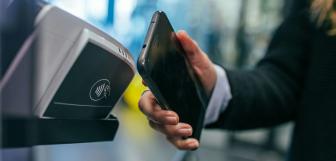What are near field communications? NFC payments guide
Do you have a smartphone? Ever paid for something with it? Then chances are you've used NFC technology. NFC, or Near Field Communication, is a way for our devices to communicate wirelessly when they're close together. It's the tech behind those quick and easy tap-and-go payments you probably use at retail or hospitality venue.
This complete guide will teach you everything you need to know about NFC technology.
What is NFC technology?
Near-field communication (NFC) technology, also called NFC tags, is a short-range wireless technology that makes smartphones, tablets, wearables, payment cards, and other devices smarter by making connectivity easier.
With NFC, you can transfer information from one NFC device to another with a single touch, using the NFC data exchange format.
Before, you had to use chip & PIN/ swipe, or sign for your purchases. But now, with NFC mobile payments, you can pay using your phone, even if you don't have your card with you.
NFC technology has been a big hit with consumers. In fact, in 2022, the global NFC market was worth nearly $21.1 billion and it's expected to grow to around $33.1 billion by 2030.
What is near field communication used for?
Now that you have a decent understanding of what NFC technology is, let's talk about places you've probably come across it, without even knowing.
- Mobile payments: Using services like Apple Pay, Google Pay, and Samsung Pay,, your customer taps their phone on an NFC reader to pay for an item or service.
- Public transport: Ever tapped your Apple watch on a terminal to ride the bus, train, or tube? That's NFC!
- Access control: If you live in a modern high-rise that uses key cards to enter buildings, or if you're staying at a hotel, NFC-enabled key cards open doors.
- Sharing files: Sending photos or contacts between two NFC-enabled devices with a tap.
- Smart posters: Scanning posters with your phone for more information or special deals.
- Pairing devices: Quickly connecting Bluetooth devices like speakers or headphones.
These are just a few common examples. NFC technology is everywhere, making daily tasks quicker and easier.
TIP
Check out our handy guide for some alternative payment methods in our handy guide. From credit card and debit card payments, to cryptocurrency and pay-in-three, we run through all of the payment trends.
Types of NFC enabled devices
We've touched on this briefly above, but what's an NFC device?
Well there are a lot of different types of electronic devices that have NFC built-in, including:
- Smartphones and mobile devices
- Tablets
- Smartwatches and other wearables
- Some laptops
All of them have NFC technology built in. This lets them talk to other NFC devices or tags wirelessly.
How do NFC mobile payments work?
It's time to get technical and talk about the science behind this brilliant technology.
NFC allows devices to talk wirelessly when they're close together. It's part of RFID (radio-frequency identification), which uses radio waves to identify things (think scanning groceries at the store or tagging luggage at the airport.)
Introduced in the early 2000s, NFC basically operates at a specific frequency (13.56MHz) for short-distance communication. At first, it was used for access cards in buildings and parking lots, but NFC has since expanded into contactless payments.
How to process NFC transactions in a business
As a business owner, there's a few steps that you have to take to be able to process NFC transactions at your retail or hospitality company.
First, you're going to need to make sure that you've got NFC-enabled payment terminals or card machines integrated into your POS system at your checkout counters. These terminals have NFC technology built-in and they can communicate with your customers' devices when they're held close to the terminal. At Epos Now, all of our card readers do this! So definitely take a look at our brilliant range.
When your customer wishes to make a payment, all they then have to do is unlock their NFC device and hold it near the reader. It'll detect the NFC signal emitted by the customer's device and establish a secure connection for payment processing.
Once the customer's device sends payment details like credit card information or digital wallet credentials to the NFC reader, the information is encrypted for security. This prevents anyone from intercepting or accessing it without permission.
The payment terminal then checks the POS transaction details and connects with the payment gateway or processor to approve the payment. This step ensures the customer has enough funds or credit for the purchase.
After approval, the POS transaction is finished, and both the customer and your business will get confirmation of the payment. Make sure your NFC terminals meet industry standards and security rules to safeguard customer information and prevent fraud.
To improve customer experience, businesses can highlight the ease and safety of NFC payments, train staff to assist customers using NFC, and update terminals regularly for the latest NFC technology and security features. NFC transactions help businesses simplify payments, speed up transactions, and meet the rising demand for contactless payments from customers.
Discover what’s possible with the Air card reader
Take payments from your pocket with the lightweight, portable, and practical payment solution.
Advantages and disadvantages of accepting NFC payments
If you're not already, you should definitely consider offering this payment option to your business. Here's why:
Advantages
- More secure: Mobile wallets like Apple Pay keep your bank details safe by scrambling them into something that fraudsters can't understand or use. Each time you make an NFC payment, new tokens are generated, making it really hard for anyone to steal your information. Apple Pay adds even more protection with fingerprint verification using Touch or Face ID, so only you can authorise payments with your unique fingerprint.
- Faster: You know those chip and PIN cards everyone has now? They're great for security, but they can be slow. EMV transactions, where the chip talks to the processor to check everything's okay, take time—especially when there's a line. NFC transactions are much quicker. They only take a few seconds. As more people realise how fast and easy contactless payments are compared to chip and PIN, businesses benefit from shorter queues and happier customers.
- More convenient: We're all used to doing everything on our phones nowadays. It's like our whole lives are in there. That's why NFC contactless payments are so convenient. You don't have to dig around for your wallet or deal with cash. Just tap your phone and you're done. It's the easiest way to pay, and more and more people are loving it for its simplicity.
Disadvantages
Now, it's not all sunshine and rainbows. There are a few things you'll need to think about before introducing NFC technology to your business. Here are some of the downsides that may come with offering an NFC tag:
- Cost: Implementing NFC technology is definitely an expense. Although it's worthwhile, you'll still need a budget to purchase compatible devices and set up infrastructure.
- Limited range: Because NFC only works over short distances, typically a few centimetres, it can restrict its use in certain applications.
- Low data transfer rate: Compared to other wireless technologies, NFC has slower data transfer rates, which may not be suitable for large file transfers or high-speed comms.
FAQ about Near Field Communications (NFC)
- Is NFC the same as contactless payments?
-
Yes, NFC is the technology behind contactless payments. When you tap your card or phone at a payment terminal to pay without inserting a card or entering a PIN, that's NFC at work.
- Is NFC safe?
-
NFC is definitely considered safe. That's because it uses encryption to protect your customer's payment info when they make transactions. Plus, if they use services like Apple Pay on their mobile device, it adds extra security with features like fingerprint authentication or Face ID.
- How do you pay with NFC?
-
Paying with NFC is easy! Just unlock your phone or hold your contactless card near the payment terminal. Wait for a moment, and once the payment is processed, you'll get a confirmation.
- How can merchants accept NFC payments?
-
Merchants need an NFC-enabled payment terminal. Customers can then tap their NFC-enabled cards or phones on the terminal to make payments. It's fast and convenient for both customers and businesses.




